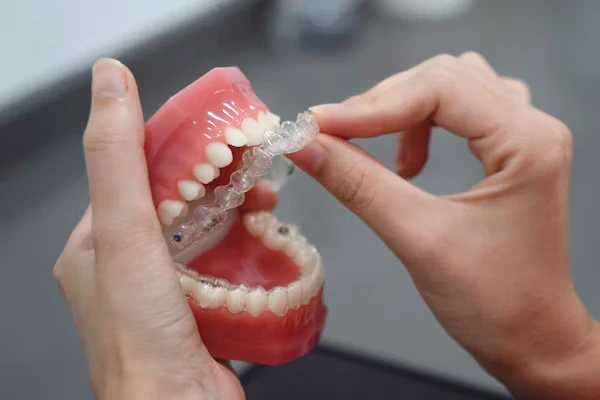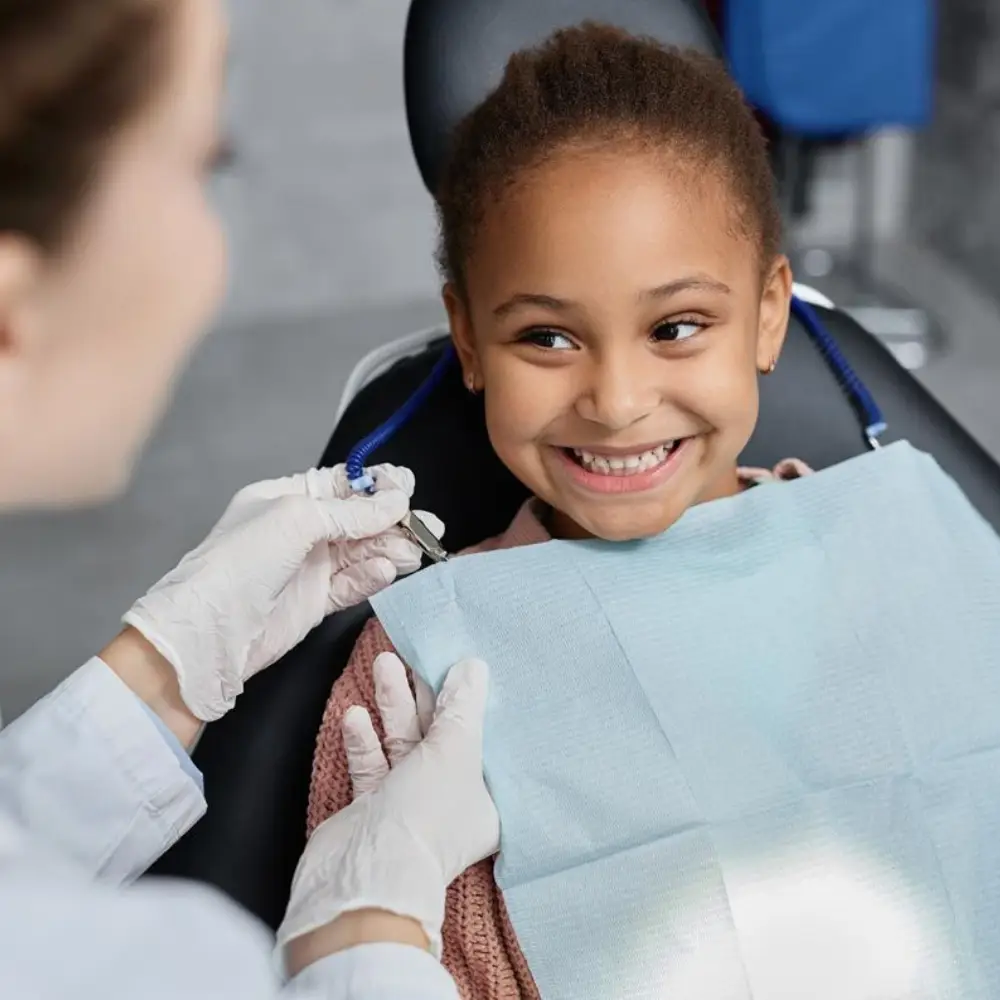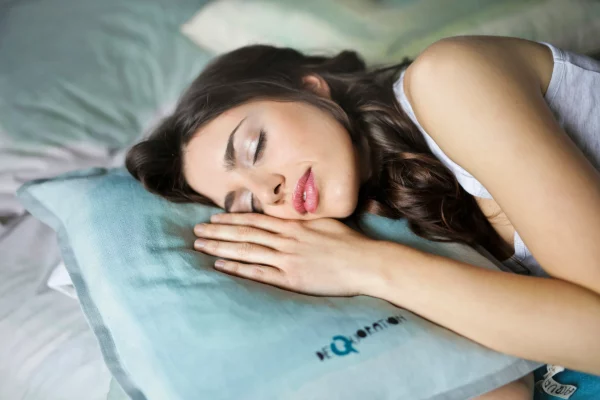Invisalign is gaining attention for more than just cosmetic improvements; it may also help with mild obstructive sleep apnea by promoting better jaw and teeth alignment. Misaligned teeth or improper bite patterns can contribute to restricted airflow during sleep, leading to snoring, restless nights, and reduced oxygen intake. By gradually repositioning the teeth and subtly adjusting the bite, Invisalign can help open the airway and support improved breathing. While it is not a substitute for CPAP therapy or other medical interventions in moderate to severe cases,
Invisalign offers a convenient and discreet approach for those with mild obstruction. In addition to potential sleep benefits, it also improves oral function, reduces strain on the jaw, and enhances overall dental health, making it a multifaceted solution for patients seeking both aesthetic and functional improvements.
Understanding the Connection Between Teeth Alignment and Sleep Apnea

Proper alignment of the teeth and jaw plays a crucial role in how air flows during sleep. When the bite is misaligned or the jaw sits too far back, it can partially block the airway, contributing to snoring and mild sleep apnea. Over time, these obstructions can interfere with restful sleep, reduce oxygen levels, and increase daytime fatigue. By addressing dental alignment, treatments like Invisalign can help improve airway space, supporting easier breathing and better sleep quality. Understanding this connection is essential for recognizing how orthodontic care may complement traditional sleep apnea management.
How Jaw Position Affects Breathing at Night
The positioning of the jaw plays a crucial role in maintaining an open airway while sleeping. If the lower jaw is recessed or misaligned, it can allow the tongue and soft tissues to partially block the airway, leading to snoring and episodes of interrupted breathing throughout the night. Over time, these obstructions can reduce oxygen intake, cause restless sleep, and increase daytime fatigue. Aligning the teeth and jaws with Invisalign can subtly bring the lower jaw forward, helping to clear the airway and improve airflow during sleep.
In addition to enhancing breathing, proper alignment can also reduce strain on the jaw muscles and temporomandibular joint (TMJ), contributing to overall oral and facial health. This approach offers a comfortable, discreet way to address mild sleep apnea while simultaneously straightening teeth.
Role of Malocclusion in Sleep Apnea Symptoms
Malocclusion, such as overbites, underbites, and crowded teeth, can disrupt the natural alignment of the jaw and tongue, narrowing the airway and making breathing during sleep more difficult. Misaligned teeth force the jaw muscles to overcompensate, creating tension that can worsen snoring and contribute to interrupted breathing episodes. This imbalance may also strain the temporomandibular joint (TMJ), causing discomfort or jaw pain. Correcting malocclusion with Invisalign not only straightens teeth but can also improve jaw positioning, reduce muscular tension, and open up the airway. By addressing these structural issues, Invisalign may help patients achieve more restful, uninterrupted sleep while promoting better overall oral and facial health.
Can Invisalign Replace CPAP Therapy?
While Invisalign can help improve airway alignment in mild sleep apnea, it is not a substitute for CPAP (Continuous Positive Airway Pressure) therapy in moderate to severe cases. CPAP remains the gold standard for keeping the airway open throughout the night, whereas Invisalign focuses on correcting structural issues such as jaw and teeth alignment that contribute to airway restriction. For patients experiencing frequent apnea episodes or significant oxygen desaturation, a consultation with a sleep specialist is essential to determine the safest and most effective treatment plan. Combining Invisalign with medical guidance may provide complementary benefits, but it should never replace prescribed therapies for severe sleep apnea.
Benefits of Invisalign for Patients with Mild Sleep Apnea

Invisalign offers more than just a discreet way to straighten teeth, it can also provide meaningful benefits for patients with mild sleep apnea. By gently realigning the teeth and jaws, Invisalign helps improve airway space and reduces obstructions that contribute to snoring and disrupted sleep. For those with mild cases, these subtle adjustments can enhance breathing patterns, promote more restful sleep, and support overall oral and jaw health.
Expanding Airway Space Through Alignment
Invisalign gradually shifts the teeth into an optimal alignment, which can also subtly reposition the jaw. This improved positioning increases oral cavity space, helping to reduce airway obstruction during sleep. By opening the airway, patients may experience smoother, more consistent breathing at night. Even modest enhancements in airway space can improve oxygen intake, decrease snoring, and contribute to more restful, restorative sleep.
Improving Tongue and Jaw Position During Sleep
Invisalign helps maintain a forward and stable position for both the jaw and tongue, which is crucial for keeping the airway open during sleep. When the tongue rests properly, it is less likely to fall backward and obstruct airflow, reducing episodes of snoring and mild sleep apnea. Over time, this improved positioning can decrease oral and jaw tension, leading to greater comfort, especially during extended periods of rest. Patients often report not only better sleep quality but also reduced morning fatigue, less daytime sleepiness, and an overall sense of improved well-being.
Boosting Sleep Quality Alongside Straighter Teeth
In addition to improving airway function, Invisalign provides the dual benefits of teeth straightening and enhanced jaw alignment. Properly aligned teeth and jaw can reduce strain on the muscles of the face and neck, leading to less tension and discomfort during sleep. Many patients notice reduced morning fatigue, better daytime alertness, and a greater sense of comfort throughout the night. Furthermore, straighter teeth are easier to clean and maintain, supporting oral health, which indirectly contributes to overall well-being and more restorative sleep. Over time, these combined benefits create a healthier, more comfortable nighttime routine.
When Invisalign Is Not Enough for Sleep Apnea
While Invisalign can help manage structural contributors to mild sleep apnea, it may not be sufficient for moderate or severe cases. Patients with frequent breathing interruptions, significant oxygen desaturation, or persistent snoring often require more intensive medical interventions. Devices like CPAP machines, oral appliances, or even surgical options may be necessary to maintain an open airway throughout the night. Consulting a sleep specialist ensures that the most effective, evidence-based treatment is selected. Invisalign can still play a supportive role, but it should be part of a comprehensive plan tailored to the patient’s needs.
Why Severe Sleep Apnea Needs Medical Treatment
Patients with moderate to severe sleep apnea typically need more advanced medical interventions to maintain an open airway throughout the night. Treatments may include CPAP therapy, custom oral appliances, or, in some cases, surgical procedures to correct structural issues contributing to airway collapse. Invisalign alone cannot fully manage the repeated obstruction of the airway seen in these cases, though it may still provide some supportive benefits. Working closely with both a dentist and a sleep specialist ensures that all aspects of the condition are addressed safely and effectively. This coordinated approach helps patients achieve better sleep, reduce health risks, and improve overall quality of life.
Combining Invisalign with Oral Appliances
In certain situations, Invisalign can be used alongside specialized oral appliances that gently reposition the jaw to maintain an open airway. This combined approach can enhance comfort and make it easier for patients to adhere to treatment compared with CPAP therapy alone. For individuals with mild to moderate sleep apnea, this strategy may improve both sleep quality and overall oral function, offering a practical and less intrusive alternative while still supporting airway health.
Consulting Both Dentists and Sleep Specialists
A multidisciplinary approach is crucial for managing sleep apnea effectively. Dentists focus on teeth alignment and jaw positioning, while sleep specialists assess airway function and monitor overall sleep quality. By collaborating, these professionals create a comprehensive, personalized treatment plan that addresses both structural and medical factors. This ensures patients benefit from improved dental alignment while receiving the necessary interventions to maintain safe, restorative sleep.
Invisalign vs. Traditional Sleep Apnea Devices
When considering treatment options for sleep apnea, patients often weigh Invisalign against traditional devices such as CPAP machines or custom oral appliances. Invisalign primarily addresses structural issues by aligning the teeth and subtly repositioning the jaw, which can improve airway space in mild cases. Traditional devices, on the other hand, mechanically keep the airway open during sleep, offering immediate relief from obstruction. Understanding the differences in function, comfort, and suitability can help patients choose the approach that best supports both oral health and restful sleep.
Comfort and Aesthetics Compared to CPAP Masks
Unlike bulky CPAP masks, Invisalign aligners are clear, lightweight, and fit snugly over the teeth, making them virtually invisible during use. Many patients appreciate that they can wear the aligners at night without feeling restricted, uncomfortable, or self-conscious. The ease of use encourages consistent nightly wear, which is essential for maximizing both dental alignment and airway benefits. Additionally, because Invisalign is removable, patients can maintain their normal oral hygiene routine without the challenges posed by traditional devices. Over time, this combination of comfort and convenience can lead to better adherence and more noticeable improvements in sleep quality.
Ease of Travel With Invisalign vs. Bulky Devices
Frequent travelers often find Invisalign especially convenient because it is portable, easy to clean, and requires no electricity, tubing, or bulky equipment. Unlike traditional CPAP machines, patients can simply pack their aligners in a small case and continue their therapy seamlessly while on the go. This portability ensures that dental and airway benefits are maintained consistently, even during extended trips or changes in routine. By supporting uninterrupted treatment, Invisalign helps travelers preserve healthy sleep patterns, reduce daytime fatigue, and maintain overall well-being while away from home.
Patient Experiences: Breathing Better and Smiling Brighter
Many patients report noticeable improvements in sleep quality and a significant reduction in snoring after consistent Invisalign therapy over several months. Beyond improving airflow and breathing efficiency, the aligners help correct dental crowding and misalignment, contributing to better oral hygiene and reduced risk of cavities or gum disease. Straighter teeth also enhance cosmetic appearance, boosting self-confidence and satisfaction with one’s smile. Together, these functional and aesthetic benefits make Invisalign a compelling option for managing mild sleep apnea while supporting overall oral health and well-being.
Frequently Asked Questions (FAQs)
1. Can Invisalign cure sleep apnea completely?
Invisalign can be an effective tool for managing mild sleep apnea, especially when dental misalignment contributes to airway obstruction. By repositioning the teeth and jaw, it can help improve airflow and reduce snoring. However, Invisalign is not a complete solution for moderate or severe cases of sleep apnea. Patients with more serious symptoms may require additional treatments, such as CPAP therapy, oral appliances, or medical interventions. Working closely with a sleep specialist ensures that all underlying issues are properly addressed. Regular follow-up appointments help monitor progress and adjust treatment as needed for optimal results.
2. Is Invisalign safe for people with diagnosed sleep apnea?
Yes, Invisalign is generally safe for patients with mild sleep apnea. Before starting treatment, dentists carefully evaluate jaw alignment, bite patterns, and overall oral health to ensure suitability. For patients with more severe sleep apnea, Invisalign is typically used in combination with other therapies rather than as a standalone solution. This collaborative approach helps address both structural and medical aspects of airway obstruction. With proper monitoring, Invisalign can safely support improved breathing and oral function.
3. Do dentists work with sleep specialists for this treatment?
Yes, coordinated care between dentists and sleep specialists is highly recommended. Dentists focus on correcting dental alignment and jaw positioning, while sleep specialists evaluate airway health and breathing patterns during sleep. By working together, they create a comprehensive treatment plan that addresses both structural and physiological factors. This collaborative approach ensures the therapy is safe, effective, and tailored to the patient’s specific needs. Ultimately, it maximizes the chances of improved sleep quality and overall well-being.
4. How do I know if Invisalign will improve my breathing?
Your dentist will evaluate your bite, jaw alignment, and tongue posture to determine whether Invisalign can help improve airway space. In some cases, additional sleep studies may be recommended to gain a complete understanding of your breathing patterns. Throughout treatment, monitoring sleep quality and snoring frequency helps track progress and effectiveness. This ongoing assessment ensures adjustments can be made if needed, maximizing both comfort and therapeutic results.
5. What alternatives exist if Invisalign isn’t effective?
For patients who do not achieve full improvement with Invisalign, alternative treatments are available. Options include oral appliances that reposition the jaw, CPAP therapy to keep the airway open, positional therapy to reduce nighttime obstruction, or surgical interventions in more severe cases. The choice depends on the severity of sleep apnea and individual patient needs. Treatment plans can be adjusted over time to ensure optimal results and improved sleep quality.
If you struggle with mild sleep apnea and want a discreet, comfortable solution that also straightens your teeth, Invisalign could be the right choice for you. By aligning your teeth and improving jaw position, you can reduce nighttime breathing issues, enhance sleep quality, and boost confidence with a healthier smile. Consult with Graham Park Dental today to explore whether Invisalign can fit into your sleep apnea management plan. Don’t wait—start improving your nights and your overall well-being now.


